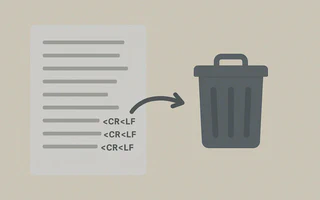CRLF entfernen

Aus historischen Gründen (Teletype) verwendet DOS/Windows zwei Steuerzeichen für den Zeilenumbruch:
Carriage Return (CR = 0x0D) und Line Feed (LF = 0x0A). Unix‑ähnliche Systeme erkannten den
Overhead und nutzen nur LF für eine neue Zeile.
Beispiel:
$ cat bacon.txt
Bacon Ipsum:
Bacon ipsum dolor sit amet salami
pork belly tail tongue pancetta,
pork loin tri-tip drumstick bresaola shankle.
$ file bacon_windows.txt bacon_linux.txt
bacon_windows.txt: ASCII text, with CRLF line terminators
bacon_linux.txt: ASCII text
$ hexdump -C bacon_linux.txt
00000000 42 61 63 6f 6e 20 49 70 73 75 6d 3a <strong>0a 0a</strong> 42 61 |Bacon Ipsum:..Ba|
00000010 63 6f 6e 20 69 70 73 75 6d 20 64 6f 6c 6f 72 20 |con ipsum dolor |
00000020 73 69 74 20 61 6d 65 74 20 73 61 6c 61 6d 69 <strong>0a</strong> |sit amet salami.|
00000030 70 6f 72 6b 20 62 65 6c 6c 79 20 74 61 69 6c 20 |pork belly tail |
00000040 74 6f 6e 67 75 65 20 70 61 6e 63 65 74 74 61 2c |tongue pancetta,|
00000050 <strong>0a</strong> 70 6f 72 6b 20 6c 6f 69 6e 20 74 72 69 2d 74 |.pork loin tri-t|
00000060 69 70 20 64 72 75 6d 73 74 69 63 6b 20 62 72 65 |ip drumstick bre|
00000070 73 61 6f 6c 61 20 73 68 61 6e 6b 6c 65 2e <strong>0a</strong> |saola shankle..|
0000007f
$ hexdump -C bacon_windows.txt
00000000 42 61 63 6f 6e 20 49 70 73 75 6d 3a <strong>0d 0a 0d 0a</strong> |Bacon Ipsum:....|
00000010 42 61 63 6f 6e 20 69 70 73 75 6d 20 64 6f 6c 6f |Bacon ipsum dolo|
00000020 72 20 73 69 74 20 61 6d 65 74 20 73 61 6c 61 6d |r sit amet salam|
00000030 69 <strong>0d 0a</strong> 70 6f 72 6b 20 62 65 6c 6c 79 20 74 61 |i..pork belly ta|
00000040 69 6c 20 74 6f 6e 67 75 65 20 70 61 6e 63 65 74 |il tongue pancet|
00000050 74 61 2c <strong>0d 0a</strong> 70 6f 72 6b 20 6c 6f 69 6e 20 74 |ta,..pork loin t|
00000060 72 69 2d 74 69 70 20 64 72 75 6d 73 74 69 63 6b |ri-tip drumstick|
00000070 20 62 72 65 73 61 6f 6c 61 20 73 68 61 6e 6b 6c | bresaola shankl|
00000080 65 2e <strong>0d 0a</strong> |e...|
00000084
Windows‑Datei zeigt 0d 0a, Linux nur 0a – das führt zu Kompatibilitätsproblemen.
Gute Editoren kommen damit klar, aber Tools wie diff sehen die Dateien als unterschiedlich:
$ diff bacon_windows.txt bacon_linux.txt
1,5c1,5
< Bacon Ipsum:
<
< Bacon ipsum dolor sit amet salami
< pork belly tail tongue pancetta,
< pork loin tri-tip drumstick bresaola shankle.
---
> Bacon Ipsum:
>
> Bacon ipsum dolor sit amet salami
> pork belly tail tongue pancetta,
> pork loin tri-tip drumstick bresaola shankle.
Ich habe gemischte Dateien in die Versionskontrolle gelegt und auf LF standardisiert. So geht die Konvertierung unter Linux:
Vim
Zwei Wege:
1
CRLFals^Manzeigen::e ++ff=unix.- Alle
^Mdurch^Nersetzen::s/\r/\r/. ^Mnur am Zeilenende entfernen::s/\r\+$//- Alle
^Mentfernen::s/^M//
^M tippt man als Ctrl+V dann Ctrl+M.
2
- Dateiformat auf unix setzen:
:setlocal fileformat=unix - Speichern:
:w - Neu laden:
:e
Mehrere Dateien konvertieren
- DOS als Format annehmen:
:set ffs=dos. - Liste der zu konvertierenden Dateien:
:args *.c *.h. - Für jedes Argument das Format ändern:
:argdo set ff=unix|w.
Weitere nützliche Optionen: :set list und :set nobomb.
sed
sed arbeitet zeilenweise. Wenn die Datei im DOS‑Format ist, kann man die letzten zwei Zeichen (CRLF) je Zeile durch LF ersetzen:
sed -i 's/.$//' arquivo.txt
Vorsicht: Ist die Datei bereits im Unix‑Format, würdest du damit das letzte Zeichen jeder Zeile löschen.
Die Gegenrichtung (Unix → DOS) mit GNU sed:
sed -i 's/$/\r/' arquivo.txt
Tofrodos
Wenn du den Status nicht prüfen willst, nutze Tofrodos – bereits konvertierte Dateien lässt es in
Ruhe. Praktisch in Skripten.
Installieren: Tofrodos (AUR) oder
dos2unix.In der Projektwurzel ausführen (hier steht
^MfürCtrl+V+Ctrl+M):grep -IUrl --color '^M' . | xargs -ifile fromdos 'file'
Konvertiert alle CR+LF zu LF rekursiv.
Für die Gegenrichtung fromdos durch todos ersetzen.